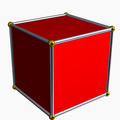Cuboid
In geometry, a cuboid is a hexahedron, a solid with six quadrilateral faces. "Cuboid" means "like a cube", in the sense that by adjusting the lengths of edges or the angles between adjacent faces, a cuboid can be transformed into a cube. In general mathematical language, a cuboid is a convex polyhedron whose polyhedral graph is the same as that of a cube.[1][2]
A special case of a cuboid is a rectangular cuboid, with six rectangle faces and adjacent faces meeting at right angles. A special case of a rectangular cuboid is a cube, with six square faces and adjacent faces meeting at right angles.[1][3]
Along with the rectangular cuboids, any parallelepiped is a cuboid of this type, as is a square frustum (the shape formed by truncation of the apex of a square pyramid).
In attempting to classify cuboids by their symmetries, S. A. Robinson found that there were at least 22 different cases, "of which only about half are familiar in the shapes of everyday objects".[4]
The numbers F of faces, V of vertices, and E of edges of any convex polyhedron are related by Euler's formula: F + V − E = 2.
In the case of a cuboid, this formula gives: 6 + 8 – 12 = 2;
that is, like a cube, a cuboid has six faces, eight vertices, and twelve edges.
Gallery[edit]
-
Trapezoidal prism
-
Non-convex cuboid
See also[edit]
References[edit]
- ^ a b Robertson, Stewart Alexander (1984). Polytopes and Symmetry. Cambridge University Press. p. 75. ISBN 9780521277396.
- ^ Branko Grünbaum has also used the word "cuboid" to describe a more general class of convex polytopes in three or more dimensions, obtained by gluing together polytopes combinatorially equivalent to hypercubes. See: Grünbaum, Branko (2003). Convex Polytopes. Graduate Texts in Mathematics. Vol. 221 (2nd ed.). New York: Springer-Verlag. p. 59. doi:10.1007/978-1-4613-0019-9. ISBN 978-0-387-00424-2. MR 1976856.
- ^ Dupuis, Nathan Fellowes (1893). Elements of Synthetic Solid Geometry. Macmillan. p. 53. Retrieved December 1, 2018.
- ^ Robertson, S. A. (1983). "Polyhedra and symmetry". The Mathematical Intelligencer. 5 (4): 57–60. doi:10.1007/BF03026511. MR 0746897.








